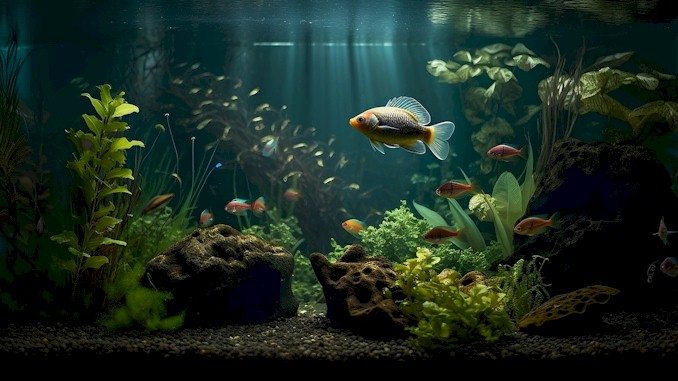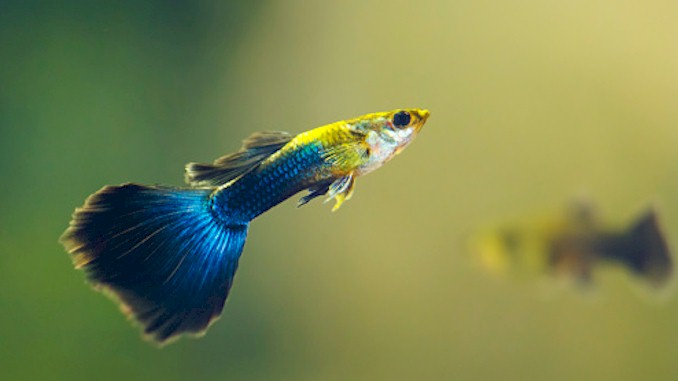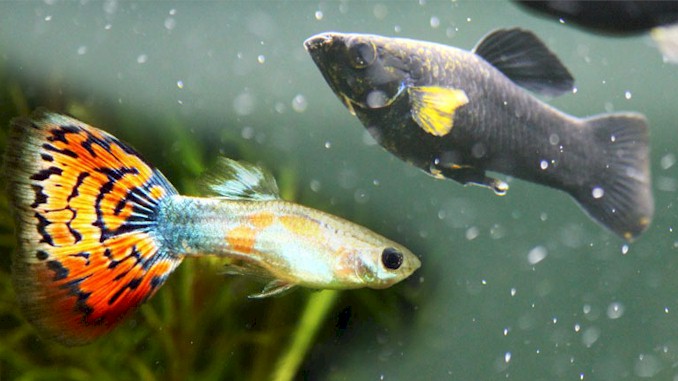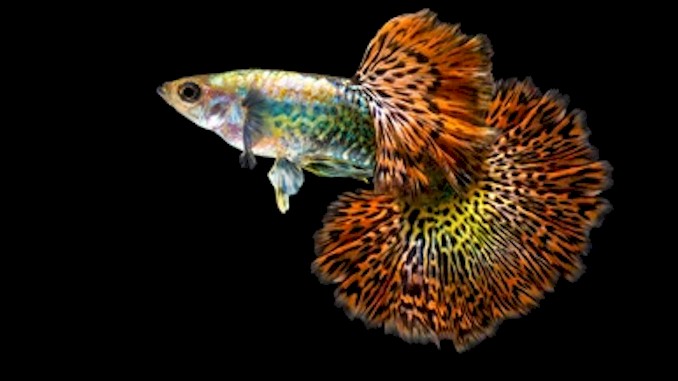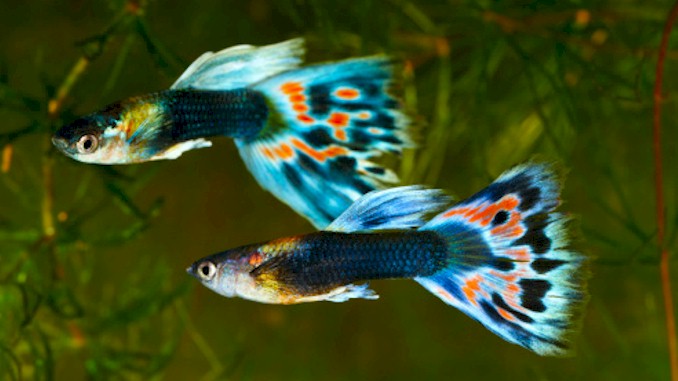Don’t Let Ammonia Ruin Your Aquarium: Learn the Signs and Combating Tank Poisoning
When I grew fish, I was continuously exposed to ammonia. Most of the time, I was too late to notice, and many of my fish were sick or dead. As time passed, I gradually learned how to detect ammonia in a fish tank and how to keep pet fish in a healthy habitat. Now I’m going to tell you what I’ve learnt about dealing with this situation that every fish lover will experience.
Ammonia is a waste product that is produced by fish and other organisms in the water. It can also come from decaying food, plants, or dead fish. Ammonia is very harmful to fish and can cause them to suffer from stress, disease, or even death. The signs of ammonia in a fish tank are:
- Cloudy or murky water
- Fish gasping at the surface or hiding at the bottom
- Red or inflamed gills, eyes, or fins
- Loss of appetite or lethargy
- Increased mortality or disease
- Your fish swim erratically
- Your fish get sick frequently
- The skin near the gills turns
If you notice any of these signs of ammonia in your fish tank, you need to act fast and take the necessary steps to lower the ammonia level and restore the water quality. Ammonia can quickly build up and cause irreversible damage to your fish and your aquarium ecosystem. But don’t worry, I have the solution that you are looking for. In this blog post, I will explain to you what causes ammonia in your fish tank, how to test for it, and how to remove it safely and effectively. I will also give you some tips on how to prevent ammonia from occurring in the first place and how to keep your fish tank clean and healthy. So, keep reading and learn how to deal with ammonia in your fish tank like a pro.
What is Ammonia and Why is it Bad for Your Fish?
Ammonia is a natural chemical that builds up in aquarium tanks as a result of life in your fish tank. It comes from a build-up of the waste produced by your fish and the things they eat. Ammonia in small amounts is not always bad and is even used by plants in your tank as fertilizer to aid in their growth. However, ammonia can quickly become toxic to your fish if it accumulates beyond a safe level.
Ammonia poisoning happens when the pH level of your water becomes too high, which makes the ammonia more harmful to your fish. Ammonia can damage the gills, eyes, fins, and organs of your fish, causing them to suffer from stress, disease, or even death. Ammonia can also affect the beneficial bacteria in your tank that help break down ammonia and other wastes.
There are several factors that can cause ammonia levels to rise in your tank, such as:
- Chemically treated tap water: Some water treatment companies use chloramine, which is chlorine bonded to ammonia, as a disinfectant for city water systems. Using tap water that has been treated with this chemical can introduce ammonia into your tank.
- Organic matter: The decomposition of organic matter, such as aquarium plants, fish excrement, and uneaten fish food, can produce ammonia in your tank. Overfeeding your fish or having too many fish in your tank can increase the amount of organic matter and ammonia in your water.
- Filter failure: If your filter stops working due to power outage, mechanical malfunction, or bacterial die-off, it can cause ammonia levels to spike. Your filter is responsible for removing ammonia and other wastes from your water and housing the beneficial bacteria that convert ammonia into less harmful substances.
- Water changes: If you do not perform regular water changes or change too much water at once, you can disrupt the balance of your tank and cause ammonia levels to fluctuate. Water changes help dilute the ammonia and other wastes in your water and replenish the minerals and oxygen that your fish need.
Ammonia is a serious threat to your fish and your aquarium. That’s why you need to know how to detect and prevent ammonia in your fish tank. In the next sections, I will show you how to test for ammonia, how to lower it if it’s too high, and how to prevent it from happening again.
How to Test for Ammonia in Your Fish Tank?
Testing for ammonia in your fish tank is a vital part of maintaining a healthy aquarium. You should test your water regularly, especially when you set up a new tank, add new fish, change the filter, or notice any signs of ammonia poisoning in your fish. There are two main methods of testing for ammonia: test kits and test strips. Here is how to use them:
Test kits
Test kits are more accurate and reliable than test strips, but they are also more expensive and require more steps. To use a test kit, you will need a test tube, a color chart, and two or three bottles of testing solution. Follow these steps to test your water with a kit:
- Get an ammonia testing kit from a pet or aquarium store. Make sure it is suitable for your type of tank (freshwater or saltwater).
- Fill the test tube with tank water to the fill line. Use a dropper or a syringe to avoid spilling.
- Add the required number of drops of testing solution #1 to the tube. Hold the bottle vertically and count carefully.
- Add the required number of drops of testing solution #2 to the tube. Some kits may have a third testing solution to add as well.
- Shake the tube for a few seconds to mix the solution.
- Let the tube sit for a few minutes until the color develops.
- Compare the color of the solution to the color chart provided with the kit. The color will indicate the level of ammonia in your water.
Test strips
Test strips are cheaper and easier to use than test kits, but they are also less precise and can expire over time. To use a test strip, you will need a strip and a color chart. Follow these steps to test your water with a strip:
- Get an ammonia test strip from a pet or aquarium store. Make sure it is suitable for your type of tank (freshwater or saltwater).
- Dip the end of the strip into your tank water for about 10 seconds. Do not submerge the entire strip.
- Remove the strip and shake off any excess water.
- Wait for a few minutes until the color develops.
- Compare the color of the strip to the color chart provided with the strip. The color will indicate the level of ammonia in your water.
The ideal level of ammonia in your fish tank is zero ppm (parts per million). Any amount of ammonia above zero can be harmful to your fish, depending on the pH and temperature of your water3. Here is a table that shows how different levels of ammonia affect your fish:
| Ammonia Level (ppm) | Effect on Fish |
|---|---|
| <0.02 | Safe |
| 0.02-0.05 | Stressful |
| >0.05 | Toxic |
| >1 | Lethal |
You should test your water at least once a week, or more often if you notice any changes in your water quality or fish behavior. If you detect any ammonia in your water, you should take immediate action to lower it and prevent it from rising again.
How to Lower Ammonia Levels in Your Fish Tank?
If you have detected any ammonia in your fish tank, you need to act quickly to lower it and protect your fish from harm. High ammonia levels can cause serious damage to your fish and your aquarium ecosystem. Fortunately, there are several ways you can lower ammonia levels in your fish tank and prevent them from rising again. Here are some of the most effective methods:
1. Partial water change
One of the simplest and most common ways to lower ammonia levels is to perform a partial water change. This means replacing some of the old water in your tank with fresh, dechlorinated water. Water changes remove ammonia and other wastes from your tank and introduce oxygen and minerals that your fish need. To perform a water change, follow these steps:
- Purchase a test kit and a water conditioner from a pet or aquarium store. A test kit will help you measure the ammonia level in your water, and a water conditioner will make tap water safe for your fish by removing chlorine, chloramine, and other harmful substances.
- Test your water with the test kit and record the ammonia level. The ideal level is zero ppm (parts per million). Any amount above zero is dangerous for your fish.
- Use a clean bucket or a siphon hose to remove 20% to 50% of the water from your tank. The amount of water you change depends on how high the ammonia level is. If it is very high (above 1 ppm), you may need to change up to 50% of the water. If it is low (below 0.5 ppm), you may only need to change 20% of the water.
- Fill another bucket with tap water and add the recommended amount of water conditioner according to the instructions on the bottle. Make sure the temperature of the new water matches the temperature of the old water as closely as possible.
- Slowly pour the new water into your tank, avoiding disturbing the fish or plants.
- Test your water again with the test kit and record the ammonia level. If it is still above zero, repeat the process until it reaches zero.
2. Cycling your aquarium
Cycling your aquarium means establishing a healthy balance of beneficial bacteria in your tank that can convert ammonia into less harmful substances. These bacteria are called nitrifying bacteria, and they live in your filter media, gravel, plants, and other surfaces in your tank. Cycling your aquarium can take several weeks, but it is essential for keeping your ammonia levels low and stable. To cycle your aquarium, follow these steps:
- Purchase a cycling aid product from a pet or aquarium store. This product contains live nitrifying bacteria that will help speed up the cycling process.
- Add the recommended amount of cycling aid product to your tank according to the instructions on the bottle.
- Add a few hardy fish to your tank that can tolerate some ammonia, such as zebra danios or cherry barbs. These fish will produce ammonia through their waste, which will feed the nitrifying bacteria.
- Test your water daily with the test kit and record the ammonia, nitrite, and nitrate levels. Nitrite and nitrate are also byproducts of nitrifying bacteria that indicate how well the cycling process is going.
- Perform partial water changes as needed to keep the ammonia and nitrite levels below 0.5 ppm and the nitrate levels below 20 ppm.
- Continue this process until you see zero ammonia and nitrite and some nitrate in your water. This means your tank is fully cycled and ready for more fish.
3. Cleaning your filter
Your filter is one of the most important parts of your aquarium, as it removes ammonia and other wastes from your water and houses most of the nitrifying bacteria in your tank. However, if your filter becomes clogged or dirty, it can lose its efficiency and cause ammonia levels to rise. That’s why you need to clean your filter regularly and properly. To clean your filter, follow these steps:
- Turn off and unplug your filter from the power source.
- Remove the filter media (such as sponge, ceramic rings, or carbon) from the filter unit.
- Rinse the filter media gently with some old tank water or dechlorinated tap water. Do not use soap or hot water, as this can kill the nitrifying bacteria on the filter media.
- Replace the filter media in the filter unit. If the filter media is very old or damaged, you may need to replace it with new media. However, do not replace all the filter media at once, as this can disrupt the bacterial balance in your tank. Replace only a portion of the filter media at a time, and keep some of the old media in the filter to preserve some of the nitrifying bacteria.
- Plug in and turn on your filter and check if it is working properly.
4. Reducing fish load
The number and size of fish in your tank can affect the amount of ammonia that is produced in your water. The more fish you have, the more ammonia they will produce through their waste. If your tank is overstocked or overcrowded, you may have trouble keeping your ammonia levels low. To reduce your fish load, follow these steps:
- Calculate the capacity of your tank by multiplying its length, width, and height in inches and dividing by 231. This will give you the volume of your tank in gallons.
- Calculate the bioload of your fish by multiplying their adult length in inches by their adult width in inches and dividing by 12. This will give you the bioload of each fish in square inches.
- Add up the bioloads of all the fish in your tank and compare it to the capacity of your tank. A general rule of thumb is to have no more than one square inch of bioload per gallon of water. For example, if you have a 10-gallon tank, you should have no more than 10 square inches of bioload in total.
- If your bioload exceeds your capacity, you may need to remove some of the fish from your tank and relocate them to another tank or give them away to a friend or a pet store. Choose the largest or most aggressive fish to remove first, as they tend to produce more ammonia and stress other fish.
- If you want to add new fish to your tank, make sure you do not exceed your capacity or bioload limit. Choose small or peaceful fish that are compatible with your existing fish and water conditions.
5. Reducing feeding
The amount and type of food you feed your fish can also affect the amount of ammonia that is produced in your water. The more food you feed your fish, the more ammonia they will produce through their waste. Moreover, any uneaten food that sinks to the bottom of your tank will decompose and release ammonia as well. To reduce feeding, follow these steps:
- Feed your fish only once or twice a day, depending on their species and size.
- Feed your fish only as much as they can eat within a few minutes. Do not overfeed them or leave any food floating or sinking in the water.
- Choose high-quality food that is suitable for your fish’s dietary needs and preferences. Avoid cheap or low-quality food that contains fillers or additives that can increase ammonia production.
- Use a gravel vacuum or a siphon hose to remove any leftover food or debris from the bottom of your tank regularly.
6. Adding live plants
Live plants can help lower ammonia levels in your tank by absorbing some of it as a source of nitrogen for their growth. Live plants can also provide oxygen, shelter, and beauty for your aquarium. To add live plants, follow these steps:
- Choose live plants that are suitable for your tank size, lighting, substrate, and water conditions. Some easy and hardy plants that can tolerate some ammonia are java fern, java moss, anubias, hornwort, and duckweed.
- Rinse the plants gently with dechlorinated tap water to remove any dirt or pests.
- Plant the plants in your substrate according to their requirements. Some plants can be attached to rocks or driftwood, while others need to be buried in gravel or sand.
- Provide adequate lighting for your plants to grow and thrive. You may need to use an artificial light source if your tank does not receive enough natural light.
- Prune and trim your plants regularly to prevent them from overgrowing or dying.
7. Adding chemical media
Chemical media are substances that can remove or neutralize ammonia and other pollutants from your water. Chemical media can be added to your filter or placed directly in your tank as a last resort when other methods fail to lower ammonia levels sufficiently. To add chemical media, follow these steps:
- Choose a chemical media that is designed to remove ammonia from your water. Some examples are zeolite, activated carbon, ammonia remover resin, and ammonia neutralizer liquid.
- Follow the instructions on the packaging of the chemical media on how to use it properly. Some chemical media need to be rinsed before use, while others need to be replaced or recharged after a certain period of time.
- Place the chemical media in your filter or in a mesh bag and put it in your tank. Make sure the water flows through the chemical media for maximum effectiveness.
- Monitor your water with the test kit and record the ammonia level. The chemical media should lower the ammonia level within a few hours or days, depending on the severity of the problem.
- Replace or recharge the chemical media as needed according to the instructions on the packaging. Some chemical media can be reused after rinsing or soaking, while others need to be discarded and replaced with new ones.
These are some of the ways you can lower ammonia levels in your fish tank and save your fish from harm. However, lowering ammonia levels is not enough. You also need to prevent ammonia from building up again in your tank. In the next sections, I will show you how to prevent ammonia buildup and maintain a healthy and balanced aquarium.
Preventing Ammonia Buildup: Proactive Measures for a Healthy Tank
To maintain a healthy fish tank environment, it is essential to prevent ammonia buildup. By taking proactive measures, you can minimize the risks associated with ammonia toxicity and create a thriving aquatic habitat. Let’s explore some effective strategies to prevent ammonia buildup and ensure the well-being of your fish.
1. Optimal Feeding Practices
Proper feeding plays a crucial role in minimizing ammonia production. Overfeeding leads to excess waste, which contributes to ammonia buildup. Follow these guidelines for optimal feeding:
- Feed your fish the appropriate amount of food based on their size and dietary requirements. Refer to feeding recommendations provided by reputable sources or consult with a knowledgeable aquarist.
- Feed in small portions multiple times a day rather than a single large feeding. This helps ensure that the fish consume all the food and reduces waste accumulation.
- Remove any uneaten food after a few minutes to prevent it from decomposing and releasing additional ammonia into the water.
2. Regular Water Changes
Performing routine water changes is crucial for maintaining a healthy tank environment. Here’s how you can incorporate water changes as a preventive measure against ammonia buildup:
- Determine the appropriate frequency and volume of water changes based on the size of your tank, the number and size of fish, and the level of waste production.
- As a general rule of thumb, aim for weekly water changes of around 10-20% of the total tank volume. Adjust this based on the specific needs of your aquarium.
- Use a reliable dechlorinator to treat tap water before adding it to the tank. Chlorine and chloramine in tap water can harm beneficial bacteria, which play a crucial role in ammonia removal.
3. Avoid Overstocking
Overstocking your tank can lead to excessive waste production, overwhelming the biological filtration system and causing ammonia levels to spike. Consider the following tips to avoid overstocking:
- Research the adult size and social compatibility of the fish species you plan to keep. This helps determine the appropriate number of fish for your tank.
- Plan your stocking carefully and consider the specific requirements of each fish species in terms of space, swimming patterns, and territorial behavior.
- Remember that different fish have varying waste production levels. Take this into account when selecting fish for your tank to maintain a manageable bio-load.
4. Beneficial Bacteria Supplements
Beneficial bacteria play a crucial role in breaking down ammonia into less harmful compounds. Introducing bacteria supplements can enhance the biological filtration process and help prevent ammonia buildup. Consider the following options:
- Use a high-quality bacterial supplement specifically designed for aquarium use. These supplements often contain a blend of beneficial bacteria strains that aid in ammonia conversion.
- Follow the manufacturer’s instructions for dosing the supplement into your tank. It is important to maintain a stable population of beneficial bacteria to ensure efficient ammonia processing.
5. Maintenance Schedule
Establishing a regular maintenance schedule is vital for preventing ammonia buildup. Here are key tasks to include in your maintenance routine:
- Regularly check and clean mechanical filtration components, such as filter pads or sponges, to prevent clogging. This ensures optimal water flow and filtration efficiency.
- Inspect and maintain your aquarium’s equipment, such as air pumps, heaters, and filters, to ensure they are functioning properly. Faulty equipment can lead to poor water circulation and inadequate filtration, potentially contributing to ammonia buildup.
By implementing these proactive measures, you can significantly reduce the risk of ammonia buildup in your fish tank. Prevention is key to maintaining a healthy aquatic environment and providing the best possible conditions for your fish to thrive.
Enhancing Water Quality: Creating a Suitable Habitat for Your Fish
Maintaining optimal water quality is crucial for the overall health and well-being of your fish. By creating a suitable habitat, you can reduce stress levels and minimize the risk of ammonia-related issues. As an expert says: “Creating a suitable habitat with optimal water quality is essential for fish health and ammonia management. Proper aeration, pH control, temperature regulation, water circulation, and the inclusion of beneficial aquatic plants can help maintain a thriving aquatic environment.”
Consider the following techniques to enhance water quality in your fish tank:
1. Adequate Aeration
Proper oxygenation is essential for fish respiration and maintaining water quality. Consider the following methods to enhance aeration:
- Use an air pump and air stone to increase surface agitation and oxygen exchange.
- Adjust the air pump’s airflow to provide adequate oxygen without causing excessive water movement that may stress certain fish species.
- Position the air stone or diffuser in a way that maximizes oxygen distribution throughout the tank.
2. Proper pH Levels
Maintaining the appropriate pH range is crucial for fish health and ammonia management. Consider the following factors to ensure optimal pH levels:
- Research the preferred pH range for the fish species in your tank and adjust your water parameters accordingly.
- Use pH test kits to monitor the pH regularly and make adjustments as necessary.
- Avoid sudden pH fluctuations, as they can stress fish and negatively impact their ability to tolerate ammonia.
3. Temperature Control
Proper temperature control plays a significant role in maintaining water quality and reducing stress in fish. Consider the following guidelines:
- Research the temperature preferences of your fish species and set the aquarium heater accordingly.
- Use a reliable thermometer to monitor the water temperature regularly and ensure it remains within the recommended range.
- Avoid extreme temperature fluctuations, as they can weaken fish immune systems and make them more susceptible to ammonia-related issues.
4. Water Circulation
Good water circulation helps maintain water quality by distributing oxygen, nutrients, and beneficial bacteria throughout the tank. Consider the following methods to enhance water circulation:
- Position your filter outlet or powerhead strategically to ensure even water flow and eliminate stagnant areas.
- Avoid blocking the filter intake or outlet with decorations or plants, as it can hinder water movement and reduce circulation.
- Use a circulation pump or wavemaker to promote water movement in larger aquariums or where natural currents are limited.
5. Beneficial Aquatic Plants
Incorporating live aquatic plants into your tank provides numerous benefits for water quality and ammonia management. Consider the following advantages of using plants:
- Plants absorb ammonia and other nitrogenous compounds as a natural part of their biological processes, helping to reduce ammonia levels.
- Live plants contribute to oxygenation, carbon dioxide absorption, and nutrient uptake, creating a more balanced and stable ecosystem.
- Certain plant species, such as Anubias, Java Fern, and Hornwort, are known for their ability to thrive in varying water conditions, including those with elevated ammonia levels.
You may build a healthier and more stable habitat for your fish by applying these water quality improvement measures. Remember to investigate the unique needs of your fish species and to test water parameters on a frequent basis to guarantee ideal circumstances. A well-kept habitat will not only reduce ammonia-related concerns, but will also support the general health of your aquatic friends.
How to Maintain a Healthy and Balanced Aquarium?
Maintaining a healthy and balanced aquarium is essential for the well-being of your fish and the overall success of your aquatic ecosystem. Achieving this requires a comprehensive approach that encompasses various factors, including water quality, nutrition, tank maintenance, and fish care. In this section, we will explore in-depth techniques and expert insights to help you maintain a thriving and balanced aquarium environment.
- Water Quality Management: Water quality is paramount in maintaining a healthy aquarium. It involves monitoring and optimizing parameters such as temperature, pH, ammonia, nitrite, nitrate, and dissolved oxygen. Consider the following aspects of water quality management:
- Temperature: Different fish species have specific temperature requirements. Research the ideal temperature range for your fish and use a reliable aquarium heater to maintain stability.
- pH Levels: Monitoring and adjusting the pH levels according to the needs of your fish is crucial. Test the pH regularly and make necessary adjustments using appropriate water conditioners.
- Ammonia, Nitrite, and Nitrate: Regularly test ammonia, nitrite, and nitrate levels to ensure they are within safe limits. Implement effective filtration systems, including biological filtration, to prevent ammonia and nitrite spikes.
- Dissolved Oxygen: Proper aeration and water circulation are essential for maintaining adequate dissolved oxygen levels. Use air pumps, surface agitation, and suitable filtration methods to ensure sufficient oxygenation.
- Nutritional Balance: Providing a well-balanced diet is essential for the health and vitality of your fish. Each fish species has specific dietary requirements, so research their nutritional needs and feed them a variety of high-quality foods. Consider the following nutritional aspects:
- Commercial Fish Foods: Choose high-quality commercial fish foods that contain a balanced blend of proteins, fats, vitamins, and minerals suitable for your fish species.
- Supplemental Foods: Include live or frozen foods, such as brine shrimp, bloodworms, or daphnia, to offer additional nutrition and variety in their diet.
- Feeding Schedule: Establish a consistent feeding schedule and avoid overfeeding, as it can lead to excess waste, nutrient buildup, and potential ammonia issues. Feed your fish small portions that they can consume within a few minutes.
- Tank Maintenance: Regular tank maintenance is crucial for maintaining a healthy and balanced aquarium environment. Consider the following aspects of tank maintenance:
- Partial Water Changes: Regularly perform partial water changes to remove accumulated toxins, excess nutrients, and waste materials. Aim for a water change of around 10-25% every 1-2 weeks, depending on your specific tank conditions.
- Substrate Cleaning: Clean the substrate periodically to remove debris and uneaten food. Use a gravel vacuum to siphon out the debris without disturbing the beneficial bacteria colonies.
- Algae Control: Monitor and manage algae growth in your aquarium by maintaining proper lighting levels, controlling nutrient levels, and regularly cleaning surfaces and decorations. Algae can compete with plants for nutrients and contribute to ammonia-related issues.
- Equipment Maintenance: Regularly clean and maintain your aquarium equipment, including filters, heaters, and air pumps, to ensure optimal functionality and prevent any potential issues.
- Fish Care and Compatibility: Caring for your fish involves understanding their specific requirements and ensuring a compatible and stress-free environment. Consider the following aspects of fish care:
- Research and Compatibility: Research the compatibility and social behavior of fish species before introducing them to your aquarium. Ensure they can coexist peacefully and thrive in the same tank environment.
- Tank Size and Stocking Density: Provide an appropriate tank size that accommodates the adult size of your fish species. Avoid overcrowding, as it can lead to increased waste production and stress on the fish.
- Observation and Behavioral Monitoring: Regularly observe the behavior of your fish to detect any signs of stress, aggression, or health issues. Act promptly if you notice any abnormalities and seek appropriate advice or treatment.
Maintaining a healthy and balanced aquarium requires attention to water quality, proper nutrition, regular tank maintenance, and ensuring fish compatibility. By focusing on these aspects and providing a suitable environment, you can create a thriving aquatic ecosystem.
Expert Insights: Advanced Strategies for Effective Ammonia Management
Ammonia management in your fish tank requires a deep understanding of the underlying factors and advanced techniques to ensure a healthy aquatic environment. In this section, we will delve into expert insights and advanced strategies that can help you effectively manage ammonia levels and promote the well-being of your fish.
Biofiltration Optimization
Biofiltration is the cornerstone of ammonia management. Advanced biofiltration techniques can enhance the efficiency of beneficial bacteria and maximize ammonia removal. Consider the following strategies:
- Increase the surface area available for beneficial bacteria colonization by incorporating specialized biofilter media, such as ceramic rings, bio balls, or porous sponges.
- Implement a multi-stage filtration system that includes mechanical, chemical, and biological filtration components to target different impurities, including ammonia.
- Monitor water parameters, including ammonia, nitrite, and nitrate levels, to assess the effectiveness of your biofiltration system.
Denitrification Processes
Denitrification is a biological process that converts nitrate (NO3-) into harmless nitrogen gas (N2) and eliminates it from the aquarium system. Implementing denitrification processes can help further reduce ammonia-related issues. Consider the following techniques:
- Utilize denitrifying bacteria that convert nitrate into nitrogen gas in oxygen-depleted areas of the tank, such as deep sand beds or specialized denitrification filters.
- Incorporate anaerobic zones in your filtration system to create an environment suitable for denitrifying bacteria growth.
- Monitor nitrate levels and adjust denitrification strategies accordingly to maintain a balanced nitrogen cycle.
Monitoring Tools and Automation
Advanced monitoring tools and automation systems can provide real-time data and simplify the management of ammonia levels. Consider the following options:
- Install an aquarium controller system that can monitor water parameters, including ammonia, and alert you to any significant fluctuations.
- Utilize ammonia-specific test kits that provide accurate and precise measurements, enabling you to fine-tune your ammonia management strategies.
- Explore automated dosing systems that can deliver water conditioners or supplements to help stabilize ammonia levels.
Nutrient Control and Algae Management
Controlling nutrient levels in your aquarium plays a vital role in ammonia management. Excessive nutrients can fuel algae growth and contribute to ammonia-related issues. Consider the following techniques:
- Implement a nutrient export system, such as a protein skimmer or a refugium, to remove excess organic matter that may contribute to elevated ammonia levels.
- Maintain a proper balance between lighting and nutrient levels to discourage algae growth, as algae can absorb ammonia during the day and release it at night.
- Regularly clean and maintain your aquarium to prevent the accumulation of detritus and decaying matter, which can contribute to nutrient buildup and ammonia production.
Advanced ammonia management techniques involve optimizing biofiltration, implementing denitrification processes, leveraging monitoring tools, and controlling nutrients. These strategies, when combined with diligent maintenance, can help ensure a stable and thriving aquatic environment.
Conclusion
Ammonia is one of the most harmful substances that can affect your fish and your aquarium. High ammonia levels can cause serious damage to your fish and your aquarium ecosystem. Fortunately, there are several ways you can lower ammonia levels in your fish tank and prevent them from rising again. By following the tips in this article, you can lower and prevent ammonia buildup in your fish tank and maintain a healthy and balanced aquarium.
A healthy and balanced aquarium is one that provides optimal conditions for your fish and plants to thrive and grow. A healthy and balanced aquarium also requires less maintenance and reduces the risk of diseases and algae outbreaks. By maintaining a healthy and balanced aquarium, you can enjoy the beauty and benefits of having an aquatic hobby for years to come.

